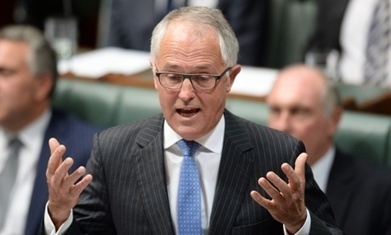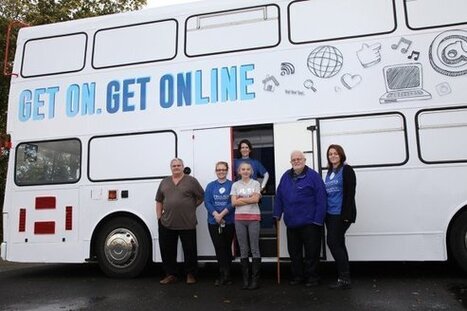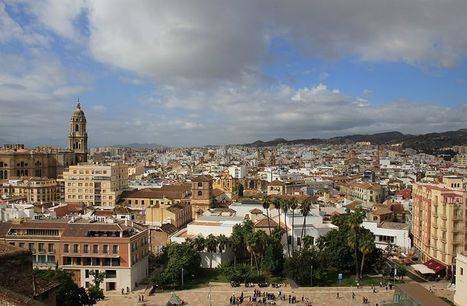 Your new post is loading...
 Your new post is loading...
The Coalition government has massively revised its plan for the National Broadband Network, breaking a promise to complete the first stage by 2016, after a strategic review found cost blowouts and poor management.
Under the new Coalition plan, the NBN will be completed with a mix of technologies containing just 26% fibre to the home, will cost almost $12bn more to complete and will take four years longer than promised by the Coalition before the election.
The revision follows the results of a scathing strategic review of the current financial and construction position of the network by the Coalition-appointed management of NBN Co.
The communications minister, Malcolm Turnbull, said the Coalition’s election policy was based on the assumption that NBN Co would meet its own forecasts, but the review marked the end of “heroic forecasts”.
“Our [election] policy was written without access to experts and information within the NBN Co and we assumed they would be further ahead than they were,” Turnbull said.
Labor immediately released an NBN Co review given to the Coalition government on 20 September, which advised the Coalition would be unlikely to achieve its promised speed of 25Mbps due to various contractual and technological obligations faced by the network.
“It shows that Malcolm Turnbull’s second-rate network will not cut it,” Labor’s communications’ spokesman Jason Clare said.
However Turnbull ridiculed the review, saying the former management had not managed to get any forecasts right under Labor.
The Coalition has revised its own projected costs of the NBN from $29.5bn promised during the election campaign to $41bn, though the minister committed to limiting its equity investment in NBN Co to $29.5bn. The rest will be funded by debt.
The government has appointed a panel of experts to conduct an independent cost-benefit analysis of broadband and a review of the regulatory arrangements for the NBN. It will be chaired by former treasury secretary and businessman Michael Vertigan, with director of the Australian Industry Group Alison Deans, economist and NBN critic Henry Ergas and regulatory consultant, telecommunications expert and economist, Tony Shaw.
The panel has been established to provide independent advice on the economic and social costs and benefits of different broadband technologies.
Click headline to read more--
In 2017, the capital of Kazakhstan will look like the set of an utopian sci-fi movie, which seems appropriate considering this is the place from where the Soviet Union conquered space. A titanic new capital will rise by the old city, powered by sun and wind. Move over Dubai. Your cliché New York-wannabe skyline is the past. This is the real future.
After several months of debate, officials in Kazakhstan's capital city of Astana have chosen a final design for the massive site that will host the World EXPO 2017. The sprawling, wind- and sun-powered neighborhood was designed by Chicago architects Adrian Smith + Gordon Gill Architecture, the designers of Kingdom Tower—the forthcoming world's tallest building in Jeddah, Saudi Arabia.
According to the chairman of the company that's heading up the EXPO 2017, Smith + Gill's design "will embody the five pillars of the Third Industrial Revolution." If that phrase sounds familiar, that's because it's borrowed from Jeremy Rifkin, economist and author of the popular 2011 book The Third Industrial Revolution, which outlines a theory of a shared clean energy grid that will transform culture and production. The reference is intentional—Rifkin has become an important figure in planning the future of Astana, a massive new city on the steppe that was built with oil money after the collapse of the Soviet Union. Click headline to read more and view pix--
The French mobile virtual network operator (MVNO) Virgin Mobile France has signed an agreement with mobile operator SFR to offer 4G services over its network, local news agency Les Echos reports. According to the article, the MVNO’s subscribers will be able to access SFR’s Long Term Evolution (LTE) network from next spring.
As previously reported by TeleGeography’s CommsUpdate, in September 2013 Virgin signed a similar leased agreement with Bouygues Telecom, with the service to be launched in the first half of 2014, due to the level of preparation required. Virgin’s CEO Pascal Rialland said: ‘The signing of this agreement with SFR for a second 4G network is great news for Virgin Mobile but also – and above all – for our customers who will benefit from high speed broadband communications over a wide area through very competitive offers.’
According to TeleGeography’s GlobalComms Database, as of November 2013 Bouygues Telecom’s LTE network offers coverage in 2,113 towns, while its rival SFR has extended its 4G footprint to 567 locations.
Virgin Mobile entered France in 2006 and claims to be the country’s largest MVNO by subscribers, with around 1.7 million users.
Samsung Electronics Co Ltd on Thursday lost its bid to ban sales of Apple Inc's older iPhone and iPad in South Korea after a court dismissed a lawsuit claiming the U.S. firm had infringed on three of Samsung's mobile patents.
The lawsuit was part of the tech giants' global courtroom battle dating to 2011, when Apple first sued Samsung for copying the look and feel of its iconic iPhone and iPad.
A judge at the Seoul Central District Court said Apple products such as the iPhone 4S, iPhone 5 and iPad2 did not violate Samsung patents on short message display methods and messaging grouping features.
The court ruled against a sale ban on the products and threw out Samsung's claim for 100 million won ($95,100) in damages.
"We are glad the Korean court joined others around the world in standing up for real innovation and rejecting Samsung's ridiculous claims," Apple Korea spokesman Steve Park said.
Samsung said it would thoroughly review the ruling before deciding to whether to appeal.
Click headline to read more--
A global study was released this morning by the Intel Corporation indicating that around the world people’s health care wants and needs are principally focused on technology and personalization. The “Intel Health Innovation Barometer” found a consistent theme: customized care.
At the intersection of health, care and technology, communities around the world consistently said they wanted to see their biological makeup and individual behaviors used to make receiving care more effective and efficient. This unsurprisingly was described by people through means such as telehealth, mobile health and the sharing of health information in real time. However, surprising methods of care were also common themes throughout the world such as ingestible monitoring systems and care that involves no utilization of hospitals.
Eric Dishman, Intel Fellow and Global General Manager of Health & Life Sciences at the company says the findings indicate that, “workflow, policy and culturally focused care are the most important ways we can improve health care.” Making care convenient, universally available and efficient through technological innovation is seen as more promising around the world than increasing the number of physicians or funding more academic research.
According to Senator Ron Wyden (D-Oregon), “People always talk about disruptors in terms of various kinds of practices in the American economy,” but “there’s nobody who’s done more disruption for the right reason than Eric Dishman.” With that kind of support to understand and advance the health care system, the Intel Health Innovation Barometer was conducted online by Penn Schoen Berland in Brazil, China, France, India, Indonesia, Italy, Japan and the United States. It was conducted among a representative sample of 12,000 adults aged 18 and older with a margin of error of +/- 0.89 percentage points.
Click headline to read more--
As we wait to be told by the Communication Minister Malcolm Turnbull’s hand-picked team that the National Broadband Network (NBN) has been an unmitigated disaster it’s perhaps an appropriate time to look at apportioning some of the blame for the mess that Turnbull will undoubtedly find.
The NBN is a nation building project that will have a significant ongoing effect on Australian society at every level, including education, health, government services, business, and entertainment.
Sounds great on paper, but the story so far has been dispiriting to say the least. So, who’s responsible for the current mess?
Was it the panel of experts, put together in 2008, to consider the tender responses for a new national telecommunications network that would support broadband services?
The panel had the temerity to advise the then Labor government that a Fibre to the Node (FTTN) network based on VDSL / copper should have been done 15 years earlier, none of the tender respondents would be able to achieve funding so soon after the GFC and the world would be soon moving to Fibre to the Premises (FTTP). What cheek!
Surely the panel’s advice that FTTN did not provide adequate connection speeds, quality and traffic class management and was not upgradeable to FTTP, which would be needed by 2020 to provide gigabit connection speeds and traffic class management, was wrong and it should shoulder the majority of the blame for leading Labor down the garden path.
Then again, maybe the lion’s share of the blame should reside with NBN Co’s senior management team that arguably setup and ran the greatest white elephant in Australian history, failed to understand the complexity of the task at every level and took every opportunity to utilise the wrong approach or technology?
While we are looking for a scapegoat, former NBN Co CEO Mike Quigley should surely be put in the stocks? What better place for him to spend his second retirement?
Quigley may have had good intentions at heart but mistakes were made under his watch. There was a failure to capture the public’s imagination, using construction companies rather than building an internal construction department, failure to get local communities to assist with the premises installation, failure to prevent the burgeoning of service class 0 and so on.
But it would be wrong to remember Quigley, NBN Co’s senior management team and the expert panel as the sole architects of the biggest public project failure in Australian history. While each have played a part, the real culprits for the demise of the Australian NBN dream lie elsewhere.
Click headline to read more--
Rural Norway is getting a broadband upgrade. Out goes last century’s DSL service and in comes gigabit fiber to the home service for villages and towns that American providers would consider unprofitable to serve.
Despite the harsh winter conditions, Altibox has already begun work installing the new fiber network in the fjord and mountain district of Hjelmeland on Norway’s west coast. The aim is to offer a fiber optic connection to each of the 2,800 residents and 1,000 seasonal vacation homeowners who want one by the end of 2016.
Installation has already begun in the fjord and mountain district. The first customers will be online by the first half of 2014. At launch, customers will be offered a package including 1,000/1,000Mbps Internet access, cable TV, and a phone line with calling and feature package for around $165 a month, considered steep for Europe but not unusual in high cost service areas.
With its widely spaced buildings and vacation homes, Hjelmeland is perhaps one of the most challenging districts in Norway to install a fiber-optic network, according to Toril Nag of Altibox.
Click headline to read more--
Media coverage of the controversy surrounding the use of certain non-native feedstocks for bioenergy is as pervasive as invasiveness itself. Plants such as giant reed (Arundo donax) and elephant grass (Pennisetum purpureum) are known to be weedy or invasive in natural habitats; the concern lies in their ability to spread propagules into natural habitats outside intended areas. So are bioenergy crops on the path to being the next kudzu (Pueraria montana)? The US Environmental Protection Agency (EPA) recently put in place growing restrictions and management plans to minimize the potential for escape when planting giant reed and elephant grass (Federal Register 2013, Scott et al. 2013).
The bad reputation and accompanying safeguards that require onerous record-keeping, monitoring, and reporting may dissuade farmers from planting feedstocks with invasive potential. But what if, on the flip side, bioenergy can serve as a motivator to remove existing weeds in farms, forests or even natural areas? That is, could ecologically damaging invaders be converted into cash crops that contribute valuable biomass to ethanol supply chains? Several authors already have proposed gasification or combustion (Jakubowski et al. 2010, Nielsen et al. 2011, Nackley et al. 2013) of existing stands of kudzu (Zaleski 2008, Sage et al. 2009); woody invaders like Russian olive (Elaeagnus angustifolia) and saltcedar (Tamarix spp.), and wetland invaders such as common reed (Phalaris arundinacea).
To date, however, the literature has not addressed whether this could actually be feasible from an economic, ecological or practical sense in the ethanol context. Sustainability standards such as the CSBP (2013) have entertained the notion that standards should reward producer actions to clear invaders for bioenergy purposes. In a recent study (Quinn et al. 2013), we examine existing barriers that could preclude commercial use of weedy and invasive biomass as a source of ethanol.
Click headline to read more--
As South Africans were forced to come to terms with the passing of former President Nelson Mandela, the significance of this event transcended the immediate implications of a South Africa without the famous global icon and statesman. It effectively held up a mirror to Africa’s economic powerhouse to reflect the realities of the country’s progress, its trials, tribulations, current status and direction.
In much the same way the country attracted global attention with the release of Nelson Mandela in February 1990 and the subsequent negotiated political transition from a National Party-led government to one under African National Congress (ANC) rule, this month, once again, the world’s eyes have been on South Africa.
However, this time, viewers were using multi-media platforms and posting news and reatlime updates immediately using digital technology and social networks. As the moments unfolded, they were documented and disseminated globally, magnifying everything that transpired.
On 10 December 2013, at the official memorial for Mandela held at the FNB Stadium in Soweto near Johannesburg, and attended by almost 100 international heads of state, the state of the Southern African country was indirectly put under the spotlight.
In addition to the many socio-economic and political issues under scrutiny in the country, almost 20-years into the post-apartheid chapter of its history, the level of South Africa’s ICT capability and technology application to help address these issues remains a critical consideration for leaders and stakeholders.
Click headline to read more--
“Smart City” is one of the trending buzzwords these days. Like all buzzwords, no one really knows exactly what it means, but let me venture a broad definition: a smart city is a city that strives to reinvent itself using technology to improve its efficiency, enhance the service it offers to citizens and visitors and adopt a more sustainable model.
There’s little doubt that the promise of smart cities is considerable. Amongst other things, a smart city approach may help address issues as diverse as:
- traffic congestion and its negative impacts on pollution, stress levels and accessibility of the city,
- sorting waste and more generally waste management,
- public transport efficiency and transparency,
- emergency information,
- post-emergency recovery,
- …
These are only a few examples of the possibilities that technology can offer to cities. You will note that connectivity enables most if not all of these services. The problem is that when it comes to connectivity, cities rarely understand the stakes and rarely control the resources.
Admittedly, the smart city “market” is still in its infancy and it’s largely driven by vendors (IBM, Thales, Cisco, etc.) who have developed certain areas of expertise, vertical applications that they tend to push to cities, sometimes going as far as financing all or part of the projects to acquire commercial references that they can then resell to other cities. As a consequence, most smart city projects are conceived top down, with the application as a starting point.
The issue with that approach is that there is no foundational understanding of the needs of the city and what the priorities are. Projects emerge because a solution exists and a vendor is available to make it happen, not necessarily because said project represents the most pressing need for the city. And that in turn leads to an accumulation of functional and technical silos that generate enormous waste in terms of infrastructure and IT resources.
Click headline to read more--
Despite the U.S. Trade Representative's concerted efforts to push through a deal, the Trans-Pacific Partnership Agreement (TPP) will not be completed by the self-imposed deadline of the end of this year. That announcement, made in Singapore today at a closed press conference, is welcome: the U.S. Trade Representative's accelerated timeline has served as yet another means of restricting transparency, and a key pressure point in its campaign to get the U.S. Congress to abdicate its oversight role by granting "fast track authority." If you're in the U.S., you can contact your legislators and tell them to oppose that effort.
The closed press conference itself was representative of the needless secrecy surrounding the negotiation of this agreement. While the TPP ministers laid out the new timeline and opened the floor to questions, public interest groups were limited to the lobby of the building—not even allowed to stand in the back of the room and watch.
Of course, the announcement also comes just days after a leaked document showed major rifts in the positions of different countries and highlighted a number of substantive proposals where the United States has failed to secure international support for its stances. The TPP ministers announced "substantial progress" in the agreement, but no firm explanation of how the situation had changed since the release of those documents.
Without such an explanation, the public continues to rely on leaks to get important information about the agreement. And while they have been very helpful, leaks are no substitute for transparency. With both this most recent and earlier disclosures—such as the WikiLeaks publication last month of an entire draft proposal for the chapter titled "Intellectual Property"—the public gets just a snapshot, which may be out of date and incomplete.
Click headline to read more--
A report from Alliance for Affordable Internet (A4AI) highlights the unaffordable cost of broadband for the two billion people who live on less than US$2/day.
For those living on less than US$2/day, entry-level broadband costs an average of 40% of monthly income, and in many countries this figure exceeds 80% or 100%. As a result, billions cannot afford to get online, entrenching the digital divide and constraining economic and social progress.
This is the key finding of the Alliance for Affordable Internet's (A4AI - a4ai.org) first Affordability Report - a major study into the drivers of internet affordability in 46 developing and emerging countries. A4AI is a global coalition of more than 40 members, whose global sponsors are Google, Omidyar Network, the UK Department for International Development and US AID.
The Report also includes an 'Affordability Index', which ranks nations across communications infrastructure and access and affordability indicators fundamental to achieving affordable internet. Malaysia, Mauritius and Brazil top the Index, with Morocco ranked as the leading developing country. Zimbabwe, Malawi and Yemen prop up the foot of the table.
The report highlights that:
With one of the highest load densities in the world, Con Edison's smart grid demonstration project encompasses a complex and diverse test bed, including critical organizations such as Wall Street, the Federal Reserve, major medical facilities, and hubs for national and global communications.
The objective of the Secure Interoperable Open Smart Grid Demonstration Project is to build a scalable smart grid prototype that promotes cyber security, reduces electric demand, increases reliability and energy efficiency, and is cost effective. In addition, the system will enable greater use of renewable energy, other distributed resources, electric vehicle charging and greater consumer participation in the energy mix. The system will be demonstrated in selected sites representing a cross-section of urban and suburban America: the horizontal city (Long Island City, Queens, the vertical city (lower Manhattan), and the suburbs (Orange and Rockland Counties, NY, and northern Bergen County, NJ).
For the NY and NJ smart grid demonstration, the Con Edison team is developing the capability to better link the utility and the customer in order to empower intelligent and energy efficient interactions. This will enable consumers to make smart decisions regarding their energy use. The secure, interoperable, open smart grid will enable consumers to charge their electric vehicles with off-peak electricity and power their homes and businesses with wind and solar resources without disrupting the reliability of electricity to their neighbors. The goal is to minimize the risks of deploying the smart grid today by providing, in one system of systems, the cyber security, interoperability, scalability, affordability, peak load management, and intelligent, collaborative control required to manage the next generation electric grid in America.
Click headline to read more--
|
You may think the prospect of climate change is alarming, a call to action to slow down our emissions of carbon dioxide and other greenhouse gases.
You’re almost certainly right. But some scientists are now suggesting you should be much more concerned than you are, because they think we may be seriously underestimating the problem.
The Geological Society of London (GSL) says the sensitivity of the Earth’s climate to CO2 could be double earlier estimates. The Society has published an addition to a report by a GSL working party in 2010, which was entitled Climate change: Evidence from the Geological Record.
The addition says many climate models typically look at short term, rapid factors when calculating the Earth’s climate sensitivity, which is defined as the average global temperature increase brought about by a doubling of CO2 in the atmosphere.
Scientists agree that a doubling of atmospheric CO2 levels could result in temperature increases of between 1.5 and 4.5°C, caused by rapid changes such as snow and ice melt, and the behaviour of clouds and water vapour.
But what the GSL now says is that geological evidence from palaeoclimatology (studies of past climate change) suggests that if longer-term factors are taken into account, such as the decay of large ice sheets, the Earth’s sensitivity to a doubling of CO2 could itself be double that predicted by most climate models.
Click headline to read more--
Russia’s State Radio Frequency Commission (SRFC) has formally approved the use of 1710MHz-1785MHz and 1805MHz-1880MHz spectrum for 4G Long Term Evolution (LTE) use, bringing to an end a lengthy period of speculation over the frequency band. In addition, the watchdog has authorised the use of 890MHz-915MHz and 935MHz-960MHz spectrum blocks for the development of 3G services.
As part of the authorisation, all holders of spectrum below the 2200MHz threshold will be required to provide services to Russian settlements with more than 1,000 residents, while carriers in possession of 2200MHz-3000MHz frequencies will be obliged to cover areas that are home to more than 10,000 citizens.
Minister of Communications Nikolai Nikiforov said that the decision ‘solves an important social problem’ and will improve the standard of communications services available across Russia.
I had heard about mesh networking before I arrived in Somaliland, but had never been in the position to actually build a mesh network. When I accepted the position as ICT instructor at Abaarso School of Science and Technology in Abaarso, Somaliland, I figured this may be my chance. I knew that the Open Technology Institute (OTI) had been developing a mesh firmware called Commotion, suitable for remote locations. Upon arriving in Somaliland I decided that building a mesh network using Commotion would be one of my top priorities.
It seemed like building a mesh network could be a difficult process. I experimented in the past with other firmware on a variety of routers, but found the configuration to be too time-consuming and difficult to set up.
I knew Commotion ran on Ubiquti hardware, designed for rough outdoor environments like Somaliland. Unfortunately, finding Ubiquti routers in Somaliland -- for that matter, getting anything into Somaliland -- is no easy task.
Somaliland is an independent autonomous region of Somalia, and is an area that is safe compared to the southern regions of Somalia. While not internationally recognized as a country, Somaliland has its own currency, government, and military.
The analogy I like to use when it comes to traveling to Somaliland is no different than that of getting to Hogwarts. Instead of running head first into an imaginary platform at the train station, you have to land in Dubai, catch a flight that leaves only once a week and then travel across a desert on one of the worst-built roads you can imagine.
While back in the US this past summer I contacted OTI and found that they would be able to provide me with the proper equipment to run and set up a mesh network using Commotion. I was so excited about the possibility of actually getting all of the equipment into Somaliland that I carefully packed everything into my carry-on.
Before I go any further, I should explain my level of experience with building networks. My only experience with networking had been taking a class at a community college in San Francisco and spending the last year troubleshooting our Internet problems at school. However, Commotion is built in such a way that little if any advanced configuration is necessary to set up a mesh network.
I first began building my network by identifying where I wanted access points on campus and mapping out distances between each spot. Having a good line of sight between each node was extremely important. Luckily we have a lot of high guard and water towers on campus so placing nodes was not an issue.
Click headline to read more--
Bay Area-based digital video startup Simple.tv is looking to launch its DVR for cord cutters in the U.K. in March of 2014, and target continental Europe soon after. Simple.tv CEO Mark Ely told me during an interview Wednesday that his company aims to launch in Germany after it introduces its product in the U.K., and then bring it to France, Spain and Italy. Later in 2014, Simple.tv wants to introduce its DVR in Australia, New Zealand and South America.
Simple.tv first launched a networked DVR capable of recording free broadcast HDTV and then streaming it to mobile devices and Roku boxes in the U.S. in late 2012. The company recently announced its second-generation hardware, which is being produced by SiliconDust, and will go on sale later this month. Ahead of that launch, Simple.tv is also going to release its very first Android app.
Click headline to read more and watch video clip--
It's taken a while for Europeans to recover from the discovery that they are being spied upon by the NSA (with some help from its friends at GCHQ and elsewhere) pretty much everywhere online and all the time, but finally the legal fightback is beginning to gather pace, at least in the UK. Things got moving in October, with a case filed at the European Court of Human Rights:
The UK spy agency GCHQ is facing a legal challenge in the European courts over claims that its mass online surveillance programmes have breached the privacy of tens of millions of people across the UK and Europe.
Three campaign groups -- Big Brother Watch, the Open Rights Group and English PEN -- together with the German internet activist Constanze Kurz, have filed papers at the European court of human rights alleging that the collection of vast amounts of data, including the content of emails and social media messages, by Britain's spy agencies is illegal.
More recently, Amnesty International also brought a case against the UK government:
Click headline to read more--
BioAg Alliance, they are calling it, a venture to use microbes and fungi to enhance crop growth and yield, help with pest resistance, and reduce inputs like water. Monsanto paid Novozymes $300 million to partner in this “game changing” venture. Monsanto will do marketing and field testing. Novozymes will do the manufacturing.
Today, the headlines are everywhere about this announcement, but the articles all say the same basic, vague things. Here at B.P.A. let’s learn more.
First of all, this will rock the world of agribusiness stereotypes. People conjure up their own images of the company Monsanto, that goes without saying. Certainly, my own impression of the Danish company Novozymes is not so green, as I’ve seen the massive building which abuts the Missouri River in Blair, Nebraska, that turns out the enzymes used for ethanol production and sits next to Cargill’s massive corn processing plant, and I know what the park-like setting looked like before this industrial complex was there.
My initial reaction to this announcement is that this venture has enormous potential, is, as they are saying, a game changer, and, it is also very green. I suspect, also, that Monsanto doesn’t want to be left out of a future where the cost-competitive advantages of more sustainable production methods using fewer expensive inputs could take off. Using biologicals to enhance yields instead of chemicals has the potential to be a game changer that could help lower the input costs for farmers. Let’s hope.
Click headline to read more--
Residents who were out and about in South Ribble or Fylde recently will have seen Progress Housing Group’s digital double-decker bus rolling into their communities.
The internet bus encouraged nearly 60 Progress Housing Group residents to get on board and get online using its very own computers and free Wi-Fi.
Residents ranged from computer savvy 16 year olds to a 90 year old resident from St Johns Court, a sheltered housing scheme in Lytham St Annes, who had his first ever experience using a computer.
The double-decker bus made nine pit stops to various Progress Housing Group communities, including sheltered housing schemes in Leyland, Longton, Penwortham, Walmer Bridge, Wesham and Freckleton as well as community centres in Penwortham and Lower Lane in Freckleton.
Setting up an email account, checking their rent account, shopping online and finding long lost relatives are just a few examples of online skills residents gained when they came on board.
Phil Lloyd, a tenant from Penwortham, said: “I’ve really enjoyed being on board the bus; it has been a great experience. I have learned how to upload photographs onto Facebook and surf the web.”
The internet bus launched Progress Housing Group’s Digital Futures initiative, a campaign to get more residents online and improve web skills. A number of free computer tenant zones in community centres, offices and sheltered housing schemes will give residents access to the internet, including the housing group’s online services. The initiative also includes training a team of ‘digital champions’ who will provide one-to-one training and support to help residents get online. A training programme for tenants, starting in January 2014, will host a variety of workshops, including an introduction to the internet, how to be safe online, and how to research your family tree online.
Click headline to read more--
The deployment of Information and Communication Technologies (ICT) for the creation of smart cities is gaining strong momentum in Europe, accentuated by the numerous pilot projects running at the regional, country and EU levels, according to research from Frost & Sullivan. The vast majority of initiatives are co-funded by the European Union's ICT Policy Support Programme and 7th Framework Programme, yet there is no clear business model for the uptake of smart cities.
Projects are carried out in the form of collaborative network established between the research community, businesses, the public sector, citizens and the wider community, and they foster an open innovation approach, according to Frost & Sullivan.
The smart city infrastructure projects revolve around energy and water efficiency, mobility, infrastructure and platforms for open cities, citizen involvement, and public administration services -- the key building blocks being technologies such as smart metering, wireless sensor networks, open platforms, high-speed broadband and cloud computing.
Click headline to read more--
Six months before she helped organize the protest known as Hands Across Riverdale, the word “fracking” didn’t mean much to Deb Eck. “Not a damn thing,” says the 52-year-old dollar-store manager. A single mother of twins, she was putting in crushing hours to provide a decent life for her daughters, who are now 12. On good days, she arrived home from work in time to help the girls with their schoolwork, tuck them into bed, and spend the rest of the night cooking and cleaning. There was no time to read about the natural-gas boom unfolding in her backyard.
One consolation for Eck’s hard work was the tranquility of her home. Riverdale Mobile Home Park’s 32 trailers sat on a leafy bank of the Susquehanna River in Piatt Township, Pennsylvania, in the state’s mountainous center, three hours from any major city. “The kids would play with the ducks in the field and had all kinds of friends,” she says. “I never had to worry about them going outside.” Nor did she worry about rent: The $200 Eck paid for her lot was well within her monthly budget.
In February 2012, she learned that her landlord had sold the property to a joint venture called Aqua-PVR Water Services, which planned to build a water-withdrawal facility for local gas-drilling operations. Piatt Township sits atop the Marcellus Shale, a 95,000-square-mile rock formation stretching from New York to West Virginia. The shale contains an estimated $500 billion worth of recoverable natural gas in Pennsylvania alone and has attracted a rush of energy companies into the region. The fuel is accessed by drilling thousands of feet down and then horizontally across a layer of sedimentary rock. Chemical-laced water is pumped underground to “fracture” the rock, creating fissures that free up the gas. The extraction process, including the horizontal drilling and hydraulic fracturing, is colloquially known as “fracking.”
Building the new plant meant evicting Riverdale’s residents. Eck and her neighbors were offered $2,500 apiece—well below the cost of moving a trailer—if they agreed to leave two months before their June 1 deadline. That figure would taper down to zero if they delayed. Eck’s main worry was where she and her daughters were going to live. But then she went online and learned about the toxic chemicals used in fracking, which have been linked to water contamination. She read about how gas development destroys the integrity of forests, wreaking havoc with resident wildlife. “The more I found out, the worse it got,” she says. “They’re going to turn this peaceful, quiet community into an industrial area, suck water out of the Susquehanna, and ruin the habitat for how many different animals. It just made you sick to your stomach.”
As Eck kept reading, she learned about the political power of the natural-gas industry. “There’s no way we’re going to be able to fight this,” she concluded. But then one of her neighbors told her that he had been talking with some environmental activists who wanted to help Riverdale’s residents. “Help us do what?” she asked.
“They want to stop this because of the fracking,” she recalls him saying.
Hearing that, Eck felt a bit encouraged. “We’ve got to all stick together, though,” she told him. “If we stick together, we can fight this. Maybe we’ll beat them.”
Click headline to read more--
A record 186 megawatts of solar were installed on the rooftops of U.S. homes in the third quarter, according to a new report from the Solar Energy Industry Association and GTM Research.
Even though the utilities installed the largest share of capacity of solar, residential is far and away the success story this year. The residential market is growing faster than any segment in the U.S. solar market and the largest number American homes in history had solar panels installed in the third quarter. Residential PV installations were up 49 percent year-over-year through the third quarter. SEIA and GTM Research expects that figure to expand to 52 percent by the end of the year.
In all, solar PV installations reached 930 MW in the third quarter, up 20 percent from the previous quarter. The figure represents the second-largest quarter for installations in U.S. history, according to the report.
To date, the U.S. has installed more than 10 gigawatts of solar capacity. And the SEIA and GTM Research forecast that by the end of the year, installations will have growth 27 percent relative to 2012.
Click headline to read more and view the graph--
It is only by fiat of a corporate-captured EPA, a bought press and willed ignorance that colony collapse continues to be known as a bee "disorder."
Neonics, systemic pesticides that work through a neurotoxin, which is applied to the seed of a plant and taken up into all its tissue so that the insect is exposed at every turn to a new vehicle bearing the same poison, work in a very orderly manner indeed. Poisoned food crops and the honeybees that pollinate them are perfectly efficient bearers of the values of the Big 6 - Monsanto, Dow, BASF, Bayer, Syngenta and DuPont. The empty beehive isn't mysterious. It is no magician's cabinet. The bees aren't disordered - they are designed. There is, that is, no Colony Collapse Disorder (CCD).
But CCD is something. It is a vocabulary of power that sets down rules regarding who may speak, what we speak about, and the conditions of that speech. Power is not "about" objects such as wooden boxes; it concerns, more precisely, their very possibility. In service to power, CCD-speak has naturalized the biases of Big 6, helping to consolidate its hegemony over our food web. As a discourse, it has created the conceptual ground for a wholly privatized and administered creature, existing only by the arbitrary whim of the market.
The philosopher Theodor Adorno called this kind of world, where the profit motive pervades every level of society, the administered world. To a great extent, honeybees are already an administered creature. Man has turned the bee into a factory animal, a workhorse that cannot exist without antibiotics and careful breeding. This reduction of honeybees to migratory worker has enfeebled them. The unmitigated use of neonicotinoids over the last 15 years is rendering them extinct.
In its attempt to cover up this state of affairs, Big 6 treats the beehive as a magician's box. Its favorite rhetorical tricks are the red herring - distraction from the problem at hand - and ignoratio elenchi, a logical fallacy whereby a related - yet irrelevant - point is proven.
The diversionary content, that honeybee decline is caused by varroa mites, lack of adequate flora, poor nutrition, antibiotics, and in-breeding, valid on its own terms, is, in fact, a well-worn list of criticisms of industrialized beekeeping, here used to deflect the fact that neonicotinoids have decimated honeybee colonies.
Another trick, "pseudo-science," pretends to address the neonic issue, cherry-picking non-peer-reviewed studies to deny the pesticides' toxicity. These sophistries are typical of administration's magic box: The false back asserts a transparency that is, in fact, opaque; the compartment isolates and fetishizes the context-less "fact."
Click headline to read more--
Online porn is big business, perhaps not so much for pornographers as it is for copyright trolls and anxious government entities. Urmann and Colleagues (U+C), a German copyright troll, is continuing the settlement letter tactics it began last year. The difference this time is that rather than pursuing downloaders via torrent tracking and threatening to out them as porn watchers if they don't pay up, U+C is now targeting viewers who have streamed allegedly infringing content from porn aggregator Redtube.
Tens of thousands of German internet users have been sent threatening letters by a law firm apparently acting on behalf of a rights-holder, on the basis that they watched copyrighted material on the pornographic video-streaming site Redtube.
The letters, issued by law firm U + C on behalf of Swiss firm The Archive AG, demand €250 ($344) per watched clip. The films in question include titles such as “Hot Stories” and “Amanda’s Secrets.”
According to the source article, a Cologne-based lawyer estimates that, based on the number of calls he alone has received, U+C has targeted 20,000-30,000 viewers.
There are multiple problems with what's going on here. First of all, The Archive AG is itself a "copyright protection" company, meaning it's acting on behalf of the porn producers through U+C, rather than producing the porn. Beyond that, the titles listed in the letters (Miriam's Adventures, Amanda's Secret, Dream Trip, Hot Stories) show up in searches only a) as part of articles detailing U+C's actions or b) as the unrelated names of websites and blogs. If this porn exists other than on Redtube, it's not easily located on the web.
Click headline to read more--
|



 Your new post is loading...
Your new post is loading...





























